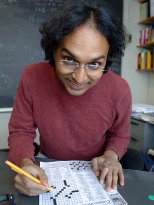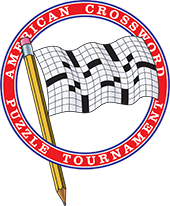MIT's crossword king girds for annual battle of wits
Source: MIT News OfficeDate: February 22, 2008
Byline: Anne Trafton
MIT's crossword king girds for annual battle of wits

A surprising number of crossword puzzle fans have backgrounds in math, computer science or some other technical field. That's certainly the case at MIT, where graduate students in the math department gather most weekday afternoons over tea to tackle The New York Times crossword puzzle.
Teamwork is encouraged, but one person usually stays on the sidelines: associate math professor Kiran Kedlaya, a champion crossword puzzle solver who could likely finish the puzzle by himself in less than 10 minutes.
"They won't let him join, because he's too good," says Michael Sipser, head of the math department.
Kedlaya, one of the top crossword solvers in the United States, is heading to Brooklyn, N.Y., this weekend for his 11th appearance in the American Crossword Puzzle Tournament.
Kedlaya studies number theory and algebraic geometry in his academic life; he enjoys crosswords because they let him combine his math skills with his interest in words and language.
"When I do crosswords, I'm using a part of my brain I don't get to use much in my job," says Kedlaya, who also composes puzzles for MIT's Mystery Hunt, held during IAP.
His best crossword tournament finish was in 2006, when he came in second place. He began doing crossword puzzles seriously in college, then started going to the tournament, made famous in the 2006 documentary "Wordplay," while a grad student at MIT.
Kedlaya finished fourth in 2005, the year the tournament was filmed for "Wordplay," and makes a couple of brief appearances in the movie.
To get ready for the tournament, Kedlaya does two or three crossword puzzles a day, mostly from The New York Times. Practice is critical to improve speed and perform well in the tournament, he says.
"Some people might be naturally good at crosswords, but you don't get to be this fast without training," says Kedlaya. "There's something similar to athletic training going on here. People are getting into shape, doing their daily puzzles, trying to get psyched up."
The New York Times crossword puzzles, which get more difficult as the week goes on, are the gold standard by which puzzle solvers judge themselves. For a really good solver, Monday's puzzle would take about three minutes, while Friday and Saturday puzzles would take seven to 10 minutes, says Kedlaya. Sunday's puzzle, which is larger, could take eight to 15 minutes.
Unlike Scrabble, another game popular with math-oriented people, crossword puzzles require knowledge of word meanings. Kedlaya suspects that is why they appeal to disparate groups of people like mathematicians and computer scientists, writers and editors, and musicians.
"There seems to be some conflation between math skills, music skills and language skills," he says.
The national tournament draws several hundred people and is the pre-eminent event for crossword puzzle solvers. Competitors solve seven puzzles during the first day of the event, with a 15-minute time limit for each one. The atmosphere can get pretty intense, Kedlaya says.
"It's like taking the SAT," he says. "Everyone is in there working on their paper. Nobody is talking."
The solvers with the top three scores (fastest times and fewest mistakes) compete in the final round, held on the second day. In that round, which Kedlaya reached in 2006, finalists solve the puzzles on large easels at the front of an auditorium, wearing headphones to block out the color commentary broadcast to spectators.
"It is pretty stressful," Kedlaya says. "You're standing in front of a room of more than 500 people, writing on an easel that is sturdy, but not completely sturdy. If you hit it too hard, it shakes."
Teaching in front of a large classroom is excellent practice for this, he says.
For the past three years, 23-year-old Tyler Hinman has won the tournament. However, Kedlaya says he's confident about his own chances going into the tournament this year. "There are a number of solvers that have a shot at the top place, and I'm in that group," he says.

